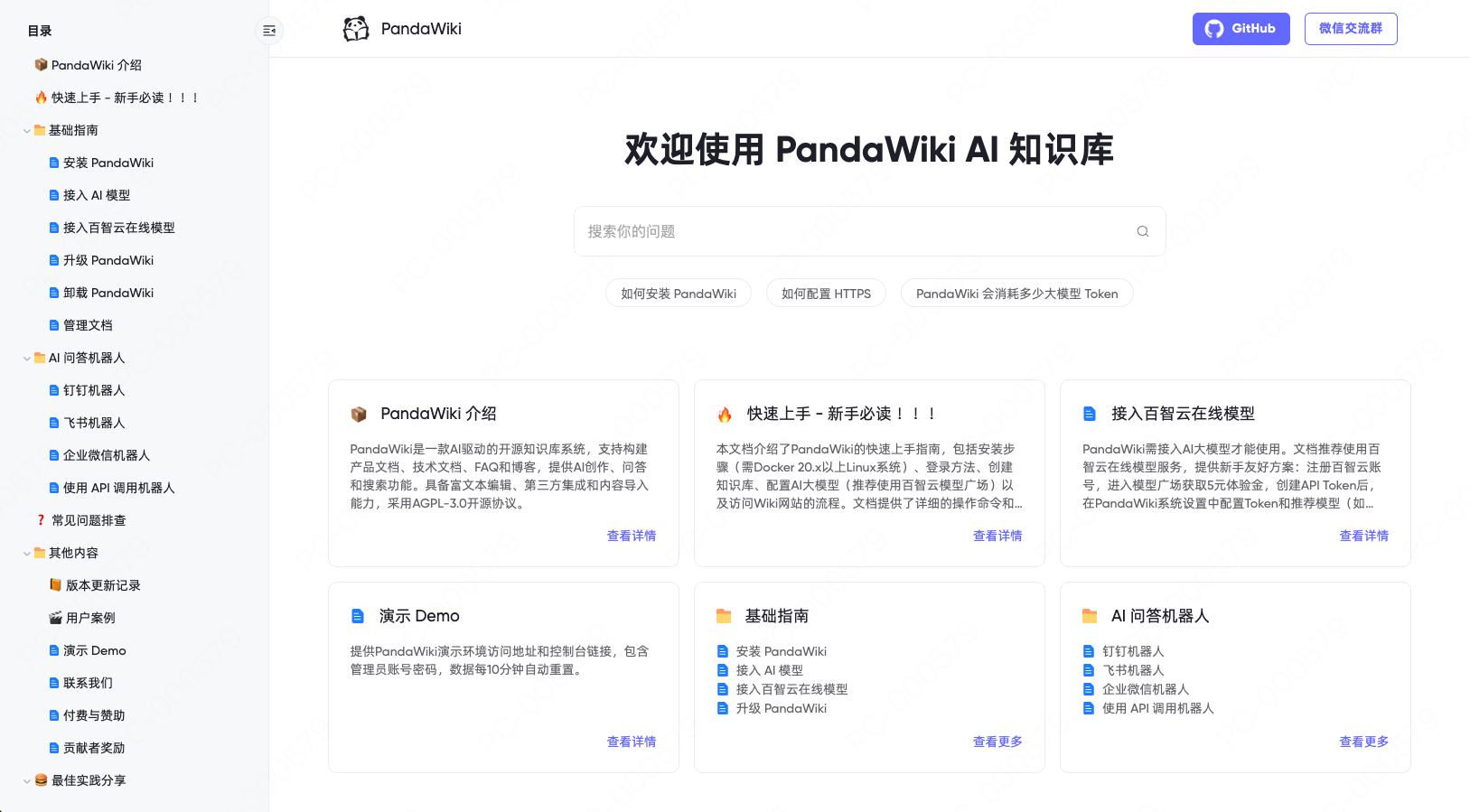PandaWiki is an open source knowledge base building system developed by Changting Technology. It uses AI big model technology to help users quickly create intelligent product documentation, technical documentation, FAQ and blog systems. The system provides content creation, Q&A and search functions through AI to simplify document management and user interaction.PandaWiki supports Docker deployment and is suitable for enterprises and individuals to quickly build a knowledge management platform. Its open source nature allows developers to freely customize and adapt to a variety of scenarios. The interface is simple, intuitive operation, suitable for technical teams and non-technical users.

Function List
- AI-powered content creation: Generate a first draft of the document through a big model to optimize the content presentation.
- AI intelligent Q&A: The user enters a question and the system automatically generates an accurate answer based on the content of the knowledge base.
- AI search function: Supports semantic search to quickly locate relevant content in the knowledge base.
- Multi-type knowledge base support: A wide range of knowledge bases can be created such as product documentation, technical documentation, FAQs and blogs.
- Docker Rapid Deployment: Simplifies installation and environment configuration through Docker containerization technology.
- Open Source Customization: Provide source code, developers can modify and extend the function according to the demand.
- Multi-language support: Supports document management and user interaction in multiple languages.
- management console: Provides an intuitive Web interface for users to manage and maintain the knowledge base.
Using Help
Installation process
PandaWiki needs to be installed on a Linux system that supports Docker 20.x or higher. Below are the detailed installation steps:
- Preparing the environment
Make sure your server has Docker 20.x or higher installed. You can check the Docker version with the following command:docker --version
If Docker is not installed, refer to the official documentation to install it.
- Execute the installation command
Log in to the server with root privileges and run the following command to download and execute the PandaWiki installation script:bash -c "$(curl -fsSLk https://release.baizhi.cloud/panda-wiki/manager.sh)"The installation process takes a few minutes, during which time you will be prompted to select configuration options. Follow the prompts to complete the installation.
- Get access to address and login information
After the installation is complete, the terminal displays a message similar to the following:SUCCESS 控制台信息: SUCCESS 访问地址(内网): http://<内网IP>:2443 SUCCESS 访问地址(外网): http://<外网IP>:2443 SUCCESS 用户名: admin SUCCESS 密码: <随机密码>Use your browser to access the address provided and enter your username
adminand password to log in to the Management Console. - Configuring the Knowledge Base
After logging in, enter the administration console and click the "New Knowledge Base" button. The system will generate a corresponding wiki site based on the input document collection. Users can upload documents or generate content through the AI authoring function. For more configuration details, please refer to the official documentation:pandawiki.docs.baizhi.cloudThe
Using the main functions
1. AI content creation
Select the "AI Creation" module in the management console, enter a topic or keyword, and the system will generate the first draft of the document based on a large model. For example, enter "Product User Guide" and AI will generate a structured draft document. You can directly edit or save it to the knowledge base. The generated document supports Markdown format, which is easy to adjust the layout.
2. AI Intelligent Q&A
In the Q&A interface of the knowledge base, the user enters a question and the system analyzes the content of the knowledge base and returns an accurate answer. For example, if you type "How do I configure a server?" , the system will extract the relevant steps from the technical documentation and answer in natural language. If the answer is inaccurate, the knowledge base content can be manually adjusted to optimize the result.
3. AI search
Enter a keyword in the search bar, and the system will return relevant documents or paragraphs through semantic search technology. Compared to traditional keyword search, PandaWiki's AI search understands the user's intent. For example, if you search for "document editing tips", even if there is no exact match in the document, the system can still find relevant content.
4. Managing the knowledge base
Through the console, you can create multiple knowledge bases, each corresponding to a separate Wiki site. It supports batch uploading of documents in PDF, Word and Markdown formats, and the system automatically parses the documents and generates searchable content. You can also set access rights to determine which users can view or edit.
5. Customized development
PandaWiki is an open source project, and developers can access it from GitHub (https://github.com/chaitin/PandaWiki) Download source code. Support secondary development, such as adding new AI functions or adjusting the interface style. Official community discussion platform is provided, where developers can exchange experiences or give feedback.
Handling Precautions
- Network Configuration: Ensure that port 2443 of the server is open, otherwise you will not be able to access the console.
- file format: When uploading documents, it is recommended to use a standard format (e.g. PDF or Markdown) to ensure accurate parsing.
- AI training: AI Q&A and search results rely on the quality of the knowledge base content, and it is recommended that the documentation be regularly updated and optimized.
- Backup Data: Regularly back up knowledge base data to prevent accidental loss.
application scenario
- Intra-enterprise knowledge management
Organizations use PandaWiki to build technical documentation and FAQ systems that make it easy for employees to quickly find product manuals or solve common problems. For example, IT teams can upload server configuration documentation and employees can access step-by-step instructions through AI Q&A. - Product Documentation Release
Technology companies use PandaWiki to build product documentation sites where customers can quickly find usage guides or troubleshooting methods through AI searches. For example, SaaS companies can create separate knowledge bases for each product. - Personal Blog System
Individual users utilize PandaWiki's AI authoring features to quickly generate blog posts and publish technical sharing or tutorial content. The system supports multiple languages and is suitable for global users. - Organization of educational resources
Schools or training institutes use PandaWiki to organize course materials, and students get study help through AI Q&A. For example, after uploading a programming tutorial, students can ask specific code questions.
QA
- Is PandaWiki free?
PandaWiki is an open source project and is free to use. You can download the source code from GitHub and deploy it yourself at no extra cost. - How much technical background is required to use it?
Deployment requires basic knowledge of Linux and Docker operations. In terms of usage, the management console interface is user-friendly and easy for non-technical users to get started. - Does the AI feature require additional configuration?
AI functionality is built-in and no additional configuration is required after installation. However, optimizing AI effects requires uploading high-quality documents as a knowledge base foundation. - What languages are supported?
PandaWiki supports multi-language documentation and interfaces, please refer to the official documentation for specific supported languages. - How do I handle installation failures?
Check that the Docker version is 20.x or higher and make sure that the network connection is stable. If it still fails, ask for help on the GitHub discussion forum.

































